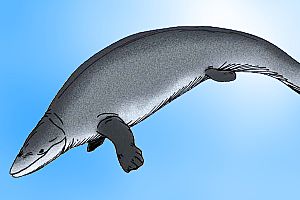Ocucajea facts for kids
Quick facts for kids Ocucajea |
|
|---|---|
 |
|
| Scientific classification | |
| Genus: |
Ocucajea
|
| Species: |
picklingi
|
Ocucajea was an extinct type of ancient whale, known as a basilosaurid. It lived during the Middle Eocene period, about 40.4 to 37.2 million years ago. Scientists found its fossils in southern Peru.
The only known fossil of Ocucajea is a partial skeleton. It was discovered in an area called Archaeocete Valley, which is part of the Paracas Formation in the Pisco Basin.
How it Got its Name
The name Ocucajea comes from the town of Ocucaje in the Ica Province of Peru. This town is close to where the fossil was found.
The second part of its name, picklingi, honors José Luis Pickling Zolezzi. He was a naturalist and artist who helped a lot with finding and studying fossils in Peru.
What Made Ocucajea Special?
Ocucajea was smaller than most other ancient whales in its group, called dorudontines.
Scientists can tell Ocucajea apart from its relatives, like Saghacetus and Dorudon, by looking at its skull. For example, its nasal bones (the bones that form the top of the snout) extended further back than its maxillae (upper jaw bones). Also, it didn't have a special bony growth on its forehead near the nose opening, which Saghacetus did have. These small differences help scientists understand how these ancient whales are related to each other.
See also
 In Spanish: Ocucajea para niños
In Spanish: Ocucajea para niños
- Prehistoric cetacean
- Evolution of cetaceans

